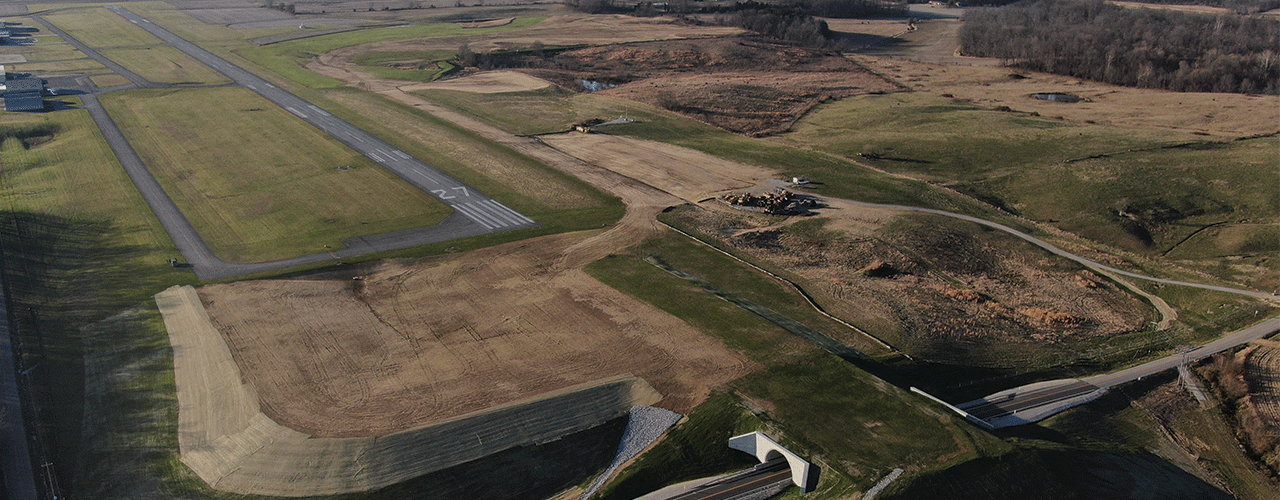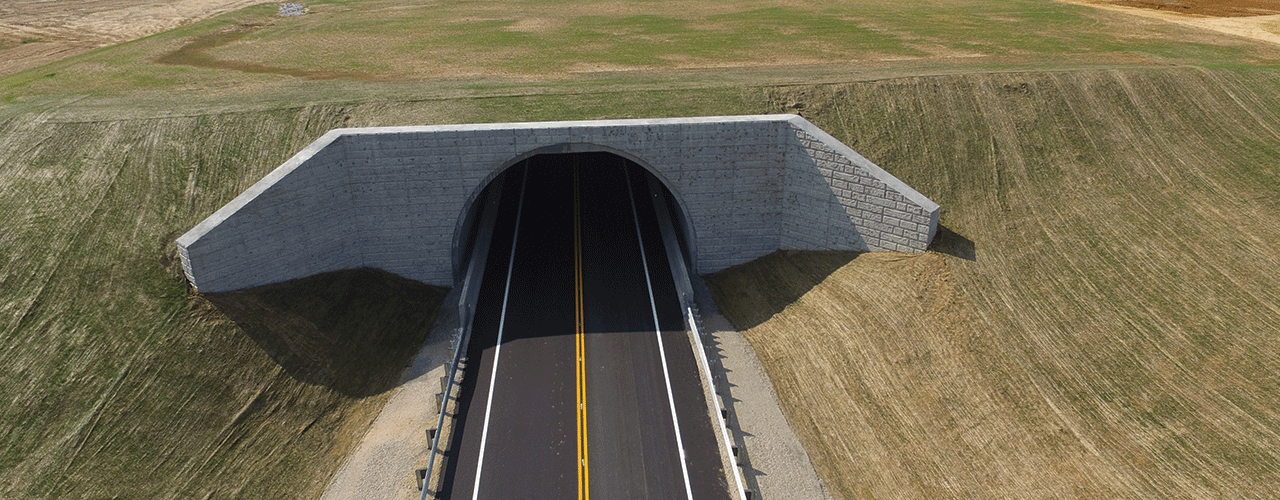HNB Runway Extension over County Road 200

The DuBois County Airport Authority wished to extend Runway 9/27 at the Huntingburg Regional Airport to meet the growing flight operation needs of local businesses. Woolpert designed a pre-cast concrete arch tunnel to support the runway extension at Huntingburg Regional Airport, which is the first pre-casted arch tunnel built in Indiana. The American Council of Engineering Companies (ACEC) of Indiana awarded Woolpert with the 2022 Engineering Excellence Merit Award for this project.
Background
Approximately 85% of businesses in Dubois County have corporate flight departments based at Huntingburg Regional Airport (HNB). Some of these businesses include well-known companies such as OFS Brands, Masterbrand, Best Chairs, Jasper Engines and Kimball Electronics. These businesses, and others, were growing but limited by the infrastructure at HNB to smaller aircraft or less than 65% of the useful load of the current fleet of aircraft.
Therefore, the Dubois County Airport Authority partnered with the county, local utility companies, the Federal Aviation Administration (FAA), and Indiana Department of Transportation (INDOT) to justify, design, and construct an extension of Runway 9/27. The runway justification study supported the extension of the Runway to 6,000 feet. However, due to funding constraints, the extension was phased into two 500-foot extensions. The first phase included a 500-foot runway and taxiway extension, lowering of County Road (CR) 200, construction of a tunnel under the runway, and relocation of utilities. The second phase extended the runway and taxiways another 500 feet and included a second tunnel under the extended taxiway.
Challenge
The project had several challenges and objectives. The first challenge was to identify how to support a 6,000-foot runway. The airport is bounded by State Highway 231 on the west and CR 200 and Railroad on the east. Because of these and other constraints, 39 different alternatives were analyzed and evaluated. These alternatives ranged from relocating the airport to realigning the State Highway or Railroad to the chosen alternative of lowering the county road and constructing a tunnel. The team’s creative problem solving, and detailed feasibility analysis were critical to all stakeholders in making informed decisions.
After the most cost-effective and practical alternative was selected, Woolpert’s design and planning team had to implement the selected improvements. The design challenges included addressing soil conditions such as muck and high organic soils in a former creek bed as well as the removal and remediation of coal seams under the tunnel headwalls. Additionally, finding an economically favorable way to import over 300,000 cubic yards of embankment was a significant design challenge for the project. Other design challenges were providing access and emergency services to several homesteads that would be isolated by the road closure and determining how to construct a tunnel in the most cost-effective way while minimizing impacts to airport operations.
Solution
Woolpert developed the design for the lowering of CR-200W by up to 9 feet and the construction of tunnel over the road that would run below the future airport runway. Because the tunnel could be constructed from the surface, Woolpert designed a pre-cast concrete arch tunnel that would not only be less expensive for construction, but also take significantly less time to build. The result was a 180-foot-long, 36-foot-wide, 19-foot and 5-inch-tall tunnel under the runway. The lowering of the roadway and the construction of the tunnel foundations were completed with no impacts to airport operations. The pre-cast tunnel was erected in only two working days while still allowing for scheduled critical flight operations.
Woolpert also designed the project so all borrowed materials could be obtained on the airport property or from adjacent landowners. As part of community outreach efforts, Woolpert engineers worked with adjacent landowners to obtain borrow material from their properties in exchange for grading the borrow areas in a manner where they could be used for crop production. These borrow areas, along with borrow obtained from the airport property, provided all the materials needed for the project.
Additionally, all unsuitable materials from the creek bed and coal seams were wasted in the borrow areas and treated to allow for crop production. Finally, Woolpert coordinated with county officials and utility companies for continuous service and access to the homesteads affected by the project. Electrical power, communications, and water lines were relocated from the CR 200 right-of-way to be outside the current and future project limits without any outages to residents. Because sections of CR 200 flood in the spring, nine homesteads would be cut off from access when CR 200 was closed during construction until the flood waters receded. Woolpert designed a temporary access road through the airport that would be opened to the public during periods of high flood waters. This egress route had to be utilized three times during construction, and it allowed residents to have emergency services and constant access to travel for work or errands.
Outcome
At the conclusion of the project, not only was the client satisfied, but airport users and neighbors were also excited and pleased. The project successfully extended the runway, was completed within the contract budget, and met the design objectives of the program. What was not expected, but was provided for by the partnership between the design team, client, and contractor, was that the project had minimal impact on airport operations and activities. As a result, the airport did not experience any loss of revenue during the completion of the project. The project was also completed ahead of schedule, which not only helped minimize impacts, but also improved community relations. Finally, the project improved surrounding properties by increasing the tillable land used for crop production.
The runway extension project has led to increased visits from the traveling public and pilots and attracted the interest of flight schools and aviation educators in developing expanded programs to serve aviation industries. It also has given local businesses the opportunity for greater service areas.
One of the indicators of the success of this project was when the local community requested a grand opening of the tunnel, which was attended by over 60 community leaders, congresspeople, and several members of the community. This tunnel and runway extension project not only signifies improved business capabilities for the national brands based in Dubois County, but also the partnership between the engineers and planners at Woolpert, the airport board and staff, county officials and the public to improve the quality of life, opportunities, and impact of their community. As the client stated, “the joint efforts and teamwork of Woolpert, Weddle Brothers, the county, and our neighbors have made this project a success.”

Benefits
The runway extension program allowed local businesses the ability to expand their service area and capabilities; it also improved the ability of the airport board to market and attract additional businesses and services to the area. The improved reputation and community relations are examples of the intangible benefits of the project. Since the design team, contractor, and client did exactly what they said, when they said they would do it, and for the cost that was agreed to—the community, businesses, and political leaders have greater confidence in stating, “Dubois County is where you want to be.”
The client benefited from increased fuel sales, increased interest in education and training activities and increased interest in expanding businesses and industry at the airport. The neighboring properties benefited by having their property improved and revenue producing opportunity increase. The public benefited by not only having local businesses expand and grow, but also by the team providing uninterrupted road access for emergency services and travel during the project. Notably, the American Council of Engineering Companies (ACEC) of Indiana awarded Woolpert with the 2022 Engineering Excellence Merit Award for our work on this project.
Client
Dubois County Airport Authority
Location
Huntingburg, Indiana